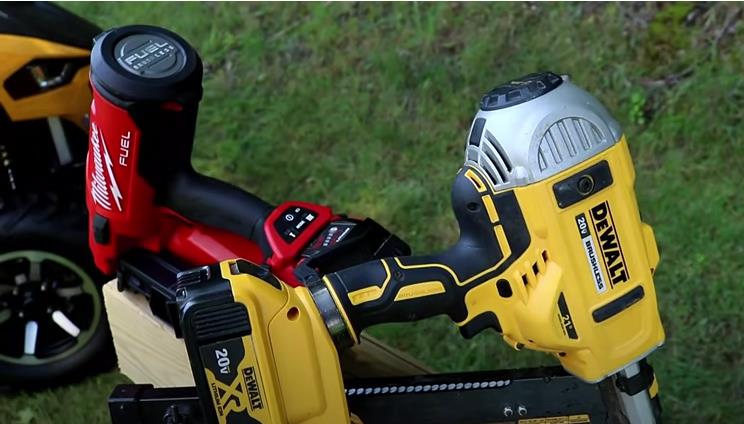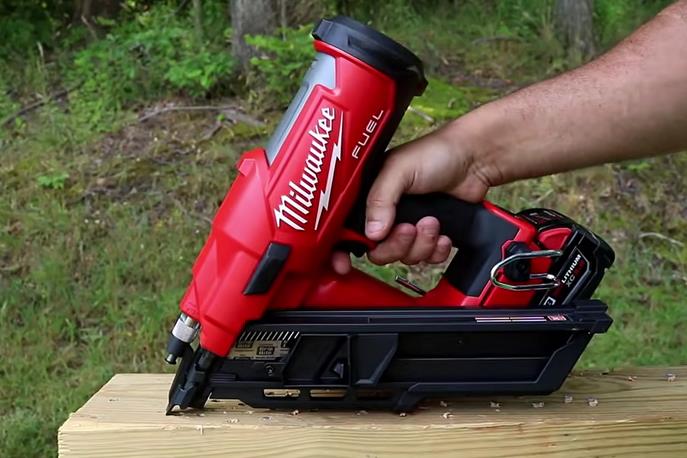There is no best degree framing nailer, as different projects require different degrees of nails.
A framing nailer is an essential tool for carpenters and DIY enthusiasts. It helps you drive nails into wood quickly and efficiently, saving you time and effort.
When choosing a degree framing nailer, there are a few things to consider. One of the most important factors to consider when choosing a framing nailer is the degree to which the nails are angled. But do you know what degree framing nailer is best for you?
There are two main types of degree framing nailers: 21-degree and 30-degree. A 21-degree framing nailer is the most commonly used and is ideal for general construction projects. It’s also the preferred choice for most DIY enthusiasts.
On the other hand, a 30-degree framing nailer is usually used for more specialized tasks, like building roof trusses and decking.
This article will discuss the best degree framing nailers and what to consider when choosing the right one for your needs.
What Degree Framing Nailer Is Best For Your Tasks?
The best degree framing nailer is the one that best suits your needs.

A degree framing nailer is a pneumatic tool used to shoot nails into wood or other materials. The term “degree” refers to the angle at which the nails are driven into the material. Degree framing nailers are mainly classified into 21-degree, 30-degree, and 34-degree. Each of these nailers has its own set of benefits and drawbacks.
21-Degree Framing Nailer
The most common type of framing nailer is the 21-degree framing nailer. It is a popular choice among carpenters and do-it-yourselfers because it is easy to use, light, and flexible. This nailer is usually used for light framing work, like putting in window and door headers.
Advantages:
- The lightweight design of the 21-degree framing nailer makes it easy to handle and operate on the job site.
- The 21-degree framing nailer is helpful because it can work with different types of framing materials and can be used for various tasks.
Disadvantages:
- The 21-degree framing nailer has less power than other framing nailers, so it can’t be used for heavy-duty framing jobs.
- Some 21-degree frame nailers can only handle nails of a certain diameter, so choosing a nailer that works with the nails you will be using is vital.
30-Degree Framing Nailer
A 30-degree framing nailer is a more powerful tool than a 21-degree nailer. This nailer is made for heavy-duty framing jobs like building a deck, a wall, or a roof.
Advantages:
- The 30-degree framing nailer is stronger than the 21-degree nailer, making it appropriate for heavy-duty framing work.
- Because the 30-degree frame nailer can handle larger diameter nails, it is appropriate for a broader range of projects.
Disadvantages:
- The 30-degree framing nailer weighs more than the 21-degree nailer, making it more challenging to handle and operate on the job site.
- A 30-degree frame nailer is often more expensive than a 21-degree nailer, making it a more expensive investment for individuals on a tight budget.
34-Degree Framing Nailer
The most specialized sort of framing nailer is the 34-degree framing nailer. It is used for certain tasks in framing, like putting in metal connectors or working with engineered lumber.
Advantages:
- The 34-degree framing nailer is more potent than the 28-degree nailer, making it ideal for heavy-duty framing work.
- The 34-degree angle of the nails in a 34-degree framing nailer makes it easier to nail in tight spaces and hard-to-reach places more accurately. This makes it an excellent tool for projects that are complicated or intricate.
Disadvantages of 34-Degree Framing Nailer
- One disadvantage of a 34-degree framing nailer is that the specialized nails required may be challenging and come at a higher cost than other types of framing nails.
- Another problem with a 34-degree framing nailer is that it can be harder to use and keep up than other types of framing nailers, especially for people new to working with it.
What Are The Different Types Of Framing Nailers?
There are many different types of framing nailers, each with its own unique features.
There are many types of framing nailers, each with its specific purpose. The most common type is the full-head nailer, which is used for framing walls and ceilings. The next most popular type is the clipped-head nailer, which is used for attaching trim and molding.
There are also coil nailers, which are used for attaching siding and roofing and finish nailers, which are used for attaching cabinets and molding.
What Are The Benefits Of Using A Framing Nailer?
A framing nailer is a type of pneumatic nail gun that is used to fasten wood together.
A framing nailer is a specialized air gun designed to shoot nails into wooden framing. It is an invaluable tool for anyone who does a lot of work with wood, such as carpentry, woodworking, or general construction. There are many benefits to using a framing nailer, including the following:
- Increased accuracy: A framing nailer allows you to be much more precise with your nails, which is essential for ensuring a strong and stable frame.
- Increased speed: A framing nailer can shoot nails much faster than you could drive them in by hand, which saves a lot of time on larger projects.
- Reduced fatigue: Because a framing nailer does the work for you, it significantly reduces the fatigue you will experience.
- Greater power: A framing nailer has much more power than you could generate by hand, meaning that you can drive nails into even the hardest of woods.
- Safety: A framing nailer is a much safer option than a hammer, as there is no risk of flying nails or accidental injuries.
A framing nailer is a great investment if you frequently work with wood. It will save you time and energy and help you create a stronger, more stable frame.
How Do I Choose The Best Degree Framing Nailer For My Project?
Choose a degree framing nailer based on the size and weight of the project.

When choosing the best degree framing nailer for your project, there are a few things you need to consider. What type of project are you working on? What is your budget? How much experience do you have?
Here are a few things to keep in mind when choosing the best degree framing nailer for your project:
What Type of Work
The first is what type of project you will be using it for. If you plan on doing a lot of finishing work, you will want a nailer with higher accuracy. For general construction work, a lower-degree nailer will suffice.
What of Nails
Another thing to consider is the size of the projects you will be working on. A lower-degree nailer will be fine if you only plan on working on small projects. However, if you plan on working on larger projects, you will want a nailer that can accommodate the larger nails.
Budget
Finally, you will want to consider the price. Higher-degree nailers tend to be more expensive than lower-degree nailers. However, they will also last longer and be more durable. Before making your final choice, you should think about all of these things when picking a degree framing nailer.
How much experience do you have:
If you are a beginner, you might want to start with a smaller, less expensive nailer. If you have more experience, you can move up to a more expensive nailer.
Here is a real-life example:
I am a beginner, and I am working on a small project. I need a framing nailer that is small and inexpensive. I found a small, inexpensive nailer at my local home improvement store.
What Are The Different Features Of Framing Nailers?

When it comes to nailing, many options are available on the market. But when it comes to framing, you want to ensure you have a framing nailer.
Here are some of the different features of framing nailers that you should consider before making your purchase:
- Head: The ability to shoot both clipped head and full round head nails. This is important because you want to be able to use the nailer for a variety of applications.
- An adjustable depth control: This feature allows you to control how deep the nails are driven into the wood.
- A tool-free jam release: This handy feature allows you to quickly and easily clear any jams that might occur.
- Anti-dry fire feature: This prevents the nailer from firing when there is no nail in the chamber.
- Safety trigger: This vital safety feature prevents the nailer from firing accidentally.
- Belt hook: This is a convenient feature that allows you to keep the nailer close at hand when you’re not using it.
Now that you know some of the different features of framing nailers, you can make an informed decision when it comes time to purchase one.
FAQ
How Do I Use A Framing Nailer?
A framing nailer is a tool that is used to drive nails into wood. It is a type of pneumatic tool that uses compressed air to drive nails into wood. Framing nailers are used to build frames, or the structural support for a structure.
What Are Some Safety Tips For Using A Framing Nailer?
There are a few safety tips to keep in mind when using a framing nailer:
1. Always wear safety goggles or glasses when using the nailer.
2. Be sure to disconnect the power source before performing any maintenance on the nailer.
3. Keep your fingers away from the trigger when not in use.
4. Be aware of your surroundings and make sure that there is nothing in the way that the nails could hit.
5. Always use the correct size and type of nail for the nailer.
How Do I Maintain My Framing Nailer?
To maintain your framing nailer, you should regularly clean the air filter and oil the moving parts. You should also check for nail jams and clean out the magazine.
Where Can I Find More Information On Framing Nailers?
A framing nailer is a type of tool that is used to drive nails into wood. There are many different types of framing nailers available on the market, so it is important to do some research to find the one that best suits your needs. You can find more information on framing nailers by doing a search online or by visiting your local hardware store.
Sum Up
There is no definitive answer to this question as the best degree framing nailer depends on the specific needs and preferences of the user.
Some factors that could influence the decision include the type of material being nailed, the size of the nails being used, and the desired level of precision.
Ultimately, it is important to choose a framing nailer that is comfortable and easy to use, as this will make the job much easier and more enjoyable.
If you still have questions about what degree framing nailer is best, please feel free to leave a comment below.

